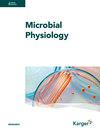Nanomolar Responsiveness of Marine Phaeobacter inhibens DSM 17395 toward Carbohydrates and Amino Acids
IF 1.2
4区 生物学
Q2 BIOTECHNOLOGY & APPLIED MICROBIOLOGY
引用次数: 1
Abstract
Phaeobacter inhibens DSM 17395 is a heterotrophic member of the ubiquitous, marine Roseobacter group and specializes in the aerobic utilization of carbohydrates and amino acids via pathways widespread among roseobacters. The in vivo responsiveness of P. inhibens DSM 17395 was studied with nonadapted cells (succinate-grown), which were exposed to a single pulse (100–0.01 µM) each of N-acetylglucosamine, mannitol, xylose, leucine, phenylalanine, or tryptophan (effectors). Responsiveness was then determined by time-resolved transcript analyses (quantitative reverse transcription-PCR) of “degradation” and “uptake” genes selected based on previously reported substrate-specific proteome profiles. The transcriptional response thresholds were: 50–100 nM for nagK (N-acetylglucosamine kinase), paaA (ring 1,2-phenylacetyl-CoA epoxidase), and kynA (tryptophan 2,3-dioxygenase), 10–50 nM for xylA (xylose isomerase), and around 10 nM for mtlK (mannitol 2-dehydrogenase). A threshold for leucine could not be determined due to the elevated intrinsic presence of leucine in the exometabolome of succinate-grown cells (no effector addition). Notably, the response thresholds for presumptive carbohydrate-binding proteins of ABC-transporters were in the same range or even lower: 0.1–1 µM for c27930 (N-acetylglucosamine) and even below 10 nM for c13210 (mannitol) and xylF (xylose). These results shed new light on the sensory/regulatory sensitivity of a well-studied roseobacter for recognizing potential substrates at low ambient concentrations and on the concentration threshold below which these might escape biodegradation (“emergent recalcitrance” concept of dissolved organic matter persistence).海洋嗜酸杆菌抑制剂DSM 17395对碳水化合物和氨基酸的纳摩尔响应性
抑黄杆菌DSM 17395是普遍存在的海洋玫瑰菌群中的异养成员,专门通过玫瑰菌中广泛存在的途径对碳水化合物和氨基酸进行有氧利用。用非适应细胞(琥珀酸盐生长)研究了抑制素DSM 17395的体内反应性,这些细胞暴露于N-乙酰葡糖胺、甘露醇、木糖、亮氨酸、苯丙氨酸或色氨酸(效应物)的单个脉冲(100-0.01µM)。然后通过基于先前报道的底物特异性蛋白质组图谱选择的“降解”和“摄取”基因的时间分辨转录物分析(定量逆转录PCR)来确定反应性。转录反应阈值为:nagK(N-乙酰葡糖胺激酶)、paaA(环1,2-苯乙酰-CoA环氧化物酶)和kynA(色氨酸2,3-双加氧酶)为50–100 nM,xylA(木糖异构酶)为10–50 nM,mtlK(甘露醇2-脱氢酶)约为10 nM。由于亮氨酸在琥珀酸盐生长的细胞的外代谢组中的固有存在增加(没有添加效应物),因此无法确定亮氨酸的阈值。值得注意的是,ABC转运蛋白的假定碳水化合物结合蛋白的反应阈值在相同的范围内,甚至更低:c27930(N-乙酰葡糖胺)为0.1–1µM,c13210(甘露醇)和xylF(木糖)甚至低于10 nM。这些结果为研究充分的玫瑰菌在低环境浓度下识别潜在底物的感官/调节敏感性以及这些底物可能逃脱生物降解的浓度阈值(溶解有机物持久性的“紧急顽固性”概念)提供了新的线索。
本文章由计算机程序翻译,如有差异,请以英文原文为准。
求助全文
约1分钟内获得全文
求助全文

 求助内容:
求助内容: 应助结果提醒方式:
应助结果提醒方式:


